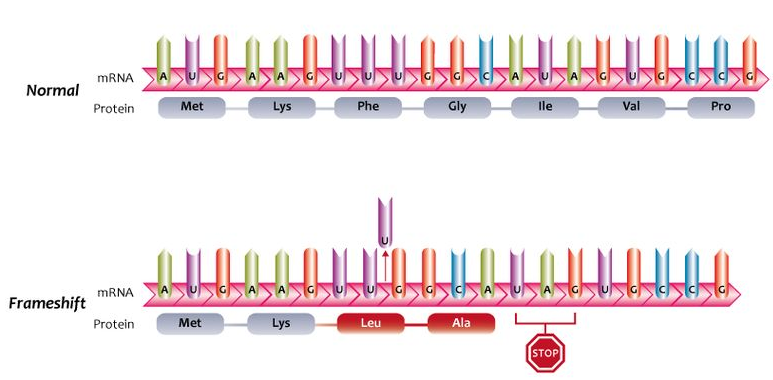
What is frameshift mutation? Name the type of mutation that does not affect the protein synthesis?
Answer
411.9k+ views
Hint: Genetic mutation that is caused by the change of a number of nucleotides in the DNA sequence. There are few mutations that lead to cease of translation or faulty amino acids. The mutations are inheritable over generations.
Complete answer:
Mutation or saltation is a new sudden stable inheritable discontinuous variation that appears in the organisms due to permanent qualitative or quantitative changes in the genetic material. In broader terms, a mutation should be a discontinuous variation that is inherited.
Frameshift mutations are those mutations in which the reading of the frame of base sequences shifts laterally either in the forward direction due to insertion (addition) of one or more nucleotides or in the backward direction due to deletion of one or more nucleotides.
Therefore, the frame-shift mutation is of two types:
a. INSERTION - One or more nucleotides are added in the segment of DNA representing cistron or gene.
b. DELETION- One or more nucleotides are lost from the segment of DNA representing cistron or gene.

Sometimes there is one insertion and one deletion of an equal number of nucleotides so that the frame does not move but mutation occurs due to a change in one or more codons.
Silent mutations are those mutations that change the DNA bases and they do not have any effect on the sequence of amino acids in the protein molecule. These mutations do not affect the structure of protein because they do not have any effect on the amino acid sequence. It can affect transcription, splicing, mRNA and translation, which can affect the phenotype.
Note: The earliest recorded mutation occurred in sheep in 1791 in Massachusetts. One male lamb in a flock of Seth Wright had usually short legs. He crossed the lamb with 15 ewes of his flock and obtained two short-legged lambs. In this way, a variety of short-legged sheep called ancon sheep came into existence. The trait of short legs is due to a double recessive allele.
Complete answer:
Mutation or saltation is a new sudden stable inheritable discontinuous variation that appears in the organisms due to permanent qualitative or quantitative changes in the genetic material. In broader terms, a mutation should be a discontinuous variation that is inherited.
Frameshift mutations are those mutations in which the reading of the frame of base sequences shifts laterally either in the forward direction due to insertion (addition) of one or more nucleotides or in the backward direction due to deletion of one or more nucleotides.
Therefore, the frame-shift mutation is of two types:
a. INSERTION - One or more nucleotides are added in the segment of DNA representing cistron or gene.
b. DELETION- One or more nucleotides are lost from the segment of DNA representing cistron or gene.

Sometimes there is one insertion and one deletion of an equal number of nucleotides so that the frame does not move but mutation occurs due to a change in one or more codons.
Silent mutations are those mutations that change the DNA bases and they do not have any effect on the sequence of amino acids in the protein molecule. These mutations do not affect the structure of protein because they do not have any effect on the amino acid sequence. It can affect transcription, splicing, mRNA and translation, which can affect the phenotype.
Note: The earliest recorded mutation occurred in sheep in 1791 in Massachusetts. One male lamb in a flock of Seth Wright had usually short legs. He crossed the lamb with 15 ewes of his flock and obtained two short-legged lambs. In this way, a variety of short-legged sheep called ancon sheep came into existence. The trait of short legs is due to a double recessive allele.
Recently Updated Pages
Master Class 11 Economics: Engaging Questions & Answers for Success

Master Class 11 Business Studies: Engaging Questions & Answers for Success

Master Class 11 Accountancy: Engaging Questions & Answers for Success

Master Class 11 English: Engaging Questions & Answers for Success

Master Class 11 Computer Science: Engaging Questions & Answers for Success

Master Class 11 Maths: Engaging Questions & Answers for Success

Trending doubts
State and prove Bernoullis theorem class 11 physics CBSE

1 ton equals to A 100 kg B 1000 kg C 10 kg D 10000 class 11 physics CBSE

State the laws of reflection of light

One Metric ton is equal to kg A 10000 B 1000 C 100 class 11 physics CBSE

1 Quintal is equal to a 110 kg b 10 kg c 100kg d 1000 class 11 physics CBSE

Difference Between Prokaryotic Cells and Eukaryotic Cells




